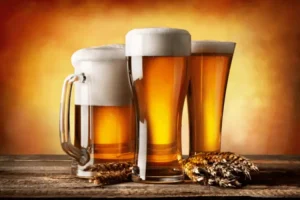
That’s why it’s best to consume alcohol safely and in moderation — without buying into any myths. This myth can especially be harmful if it causes you to drink more than you can handle — so always pay attention to the alcohol content in your drinks and be honest with what your body can manage. In fact, alcohol can make sleep worse and menopausal symptoms like hot flashes and night sweats more pronounced. Consuming alcohol during menopause can also increase the risk of heart disease and osteoporosis, says Dr. Jewel M. Kling, M.D., M.P.H., a physician with Mayo Clinic Women’s Health in Arizona.
- However, willpower can be a strong tool for those in recovery from substance use disorder.
- The truth is that time passing is the only way for alcohol to wear off.
- Here are 10 popular myths about drinking water that have been put to rest.
- With your first drink, alcohol floods your brain with dopamine, giving you a temporary stress-relieving boost.
Life
In other words, coffee may just mask the feeling of being drunk, which is still not good. “The alertness can create the perception that you aren’t as drunk or intoxicated as you actually are, and you may decide to have another drink or to drive home,” he adds. Using any kind of alcoholic beverage to help you sleep is always going to backfire, even if in the moment it feels like it’s helping. Alcohol interferes with normal brain activity, no matter how you feel when you drink.

Myth: It’s OK to get drunk every once in a while.

Higher tolerance can lead to higher levels of drinking, which can have negative health effects. Since alcohol affects multiple major organ systems, drinking in excess increases the possibility of health problems in all parts of the body. High tolerance also increases your risk for dependence and addiction. While drinking has become a fixture in many people’s lives, it’s important to remember that it comes with risks.
Myth Five: Drinking One Drink an Hour Keeps You Sober Enough to Drive
By Buddy TBuddy T is a writer and founding member of the Online Al-Anon Outreach Committee with decades of experience writing about alcoholism. Because he is a member of a support group that stresses the importance of anonymity at the public level, he does not use his photograph or his real name on this website. But there myths about alcoholism are many misguided beliefs about alcohol and alcohol use, some of which can interfere with you or someone you love recognizing the warning signs of alcohol misuse and seeking help. By learning the facts about alcohol use, you can be better prepared to drink responsibly.

Water intake on an empty stomach detoxifies your body
- If you’re struggling with alcohol in some way and considering a life of sobriety, remember that «you are not the problem,» said McKowen.
- «You do because most of our culture drinks.» Being the only one not drinking can be pretty un-fun when alcohol is the center of the gathering.
- The calories can produce an immediate source of energy which causes food that is normally used for energy production to be changed into fat and stored in the body for later use.
- If you or someone you love is drinking daily for pain relief, you’ll also likely build up a tolerance, needing more to achieve the same pain-relieving effects.
The direct action of alcohol causes a drop in the internal body temperature by the following process. The blood vessels are opened (dilated) on the skin surfaces and the blood is cooled by greater exposure to the outer environment. As the cooled blood circulates, the core temperature is lowered gradually, but significantly.
Myth: Eating a big meal before you drink will keep you sober.
It has nothing to do with what your breath smells like, so covering up the smell of alcohol with something a mint doesn’t help. Think about it this way – would we judge someone with diabetes or cancer for having an illness? Addiction works in the same way, affecting both our physical and mental health. While it’s true that relapses can happen during the recovery journey, that doesn’t mean that treatment is ineffective. In fact, research shows that individuals who engage in comprehensive and personalized recovery programs have higher success rates in achieving long-term sobriety.

There are things you can do to drink responsibly, and understanding the way it affects your body and issues it may cause are one place to start. If a recent doctor’s appointment told you that your liver is in good shape, don’t think that’s a free excuse to drink heavily. In fact, drinking can affect other parts of your body as well. This includes your heart, blood pressure, kidneys and mental health. But while women may reach the “drunk driving” limit — 0.08 percent blood alcohol — sooner, alcohol can impair https://ecosoberhouse.com/ driving at much lower blood alcohol levels. So “don’t drink and drive” remains sound advice for everyone.
Myth #3: I Am Too Old to Have a Drinking Problem
Tolerance comes from chronic use of alcohol that results in physical and mental adaptation to its presence in the body. The development of tolerance is shown by an increase in the amount of alcohol required to produce the desired effects and can indicate the onset of physical dependence. What is a healthy range of drinking for men and women age 65 years or older? Experts recommend no more than 3 drinks in a single day or no more than a total of 7 drinks a week. A drink is defined as 12 fluid ounces (355 mL) of beer, 5 fluid ounces (148 mL) of wine, or 1½ fluid ounces (45 mL) of liquor. Many people may believe the myth that loading up on bread, heavy foods, or even drinking coffee will lower your blood alcohol level.
Myths about drinking alcohol
Older women are often more sensitive to the effects of drinking than older men, although many men become more sensitive, as well. In addition, drinking while on certain medications can be dangerous. If you or someone you love is drinking daily for pain relief, you’ll also likely build up a tolerance, needing more to achieve the same pain-relieving effects.
You really have to admire a person who can hold his/her liquor.
- There’s no safe level of consuming alcohol—and the health benefits are vastly out-stated.
- For some people who drink, it takes quite a few drinks to «get a buzz» or feel relaxed, and they may be less likely to show signs of intoxication compared to others.
- For a typical 160-pound man, this would translate into 7 grams of alcohol in an hour.
- While alcohol may make socializing feel easier, it can lead to oversharing, misinterpreting others’ emotions, and not presenting yourself as intended.
- In simple terms, breathalyzers detect alcohol by using a chemical reaction to remove alcohol from the air and force it to react with another compound.
- You may hear a lot of tales around how to make drinking “easier” or “healthier,” but in reality, there aren’t any shortcuts or magic tricks out there.
- It’s important to be aware that alcohol doesn’t have to be a part of those things, Dr. Oesterle says.
It affects more than 14 million adults in the U.S — about 1 out of every 18 people in this age group. Regardless of the guidelines, drinking can be problematic if it results in negative feelings, choices, or outcomes, which is highly individualistic. Another study found that social drinkers showed significantly reduced amygdala reactivity to threat signals when shown neutral and angry faces. This suggests that alcohol impairs their ability to pick up on social cues that others may be uninterested or angry.
